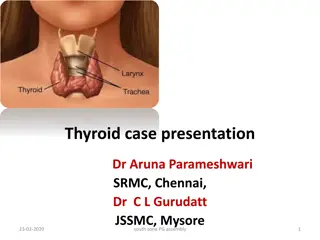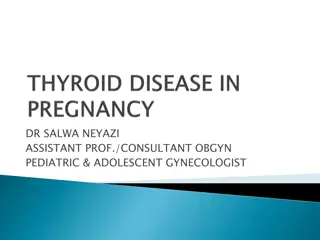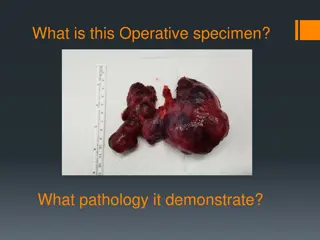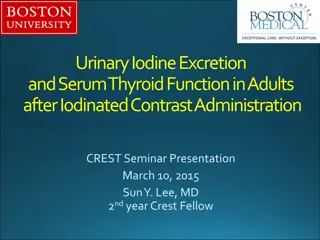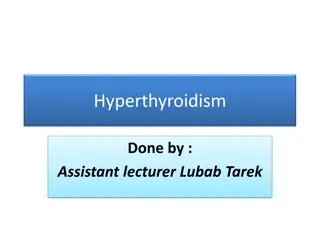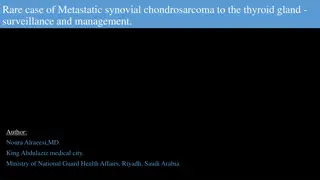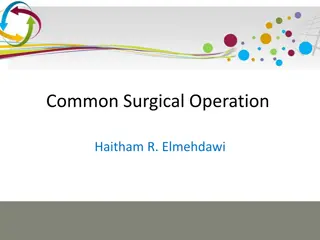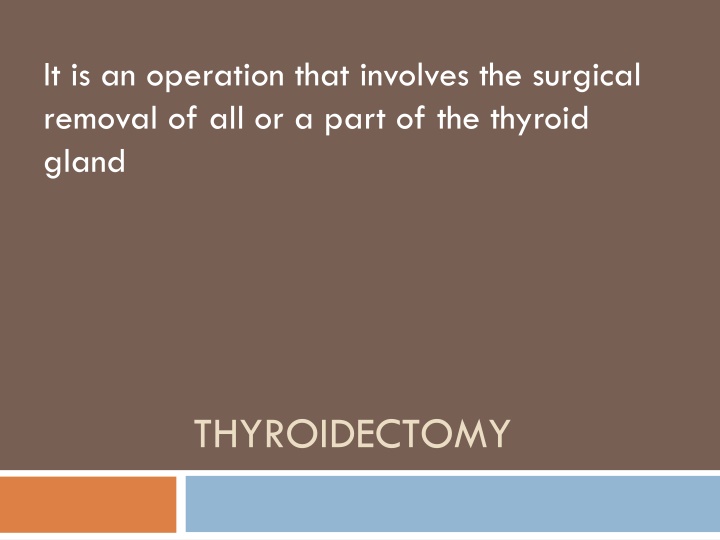
Understanding Thyroidectomy and Thyroid Function
Learn about thyroidectomy, a surgical procedure to remove all or part of the thyroid gland, and the role of the thyroid in hormone production, metabolism regulation, and calcium absorption. Discover indications for thyroid surgery and common thyroid disorders.
Download Presentation

Please find below an Image/Link to download the presentation.
The content on the website is provided AS IS for your information and personal use only. It may not be sold, licensed, or shared on other websites without obtaining consent from the author. If you encounter any issues during the download, it is possible that the publisher has removed the file from their server.
You are allowed to download the files provided on this website for personal or commercial use, subject to the condition that they are used lawfully. All files are the property of their respective owners.
The content on the website is provided AS IS for your information and personal use only. It may not be sold, licensed, or shared on other websites without obtaining consent from the author.
E N D
Presentation Transcript
It is an operation that involves the surgical removal of all or a part of the thyroid gland THYROIDECTOMY
The Thyroid Gland The thyroid is an endocrine gland located at the front of the neck below the larynx and around the trachea. Iodine, an element found in many foods, is taken up by the thyroid to produce thyroid hormone. Thyroid disorders are very common. Although small, the thyroid plays a large role in producing hormones that every cell in our body relies on for the proper conversion of calories and oxygen to energy. Color brownish red due to increase blood supply Nerves important for voice pass through thyroid
In other words, metabolism regulation is dependent on thyroid function and the condition of thyroid gland. This gland secretes essential hormones called thyroid hormones that are responsible for proper growth and development, balanced metabolism, and proper regulation of body s temperature. Many people have an undiagnosed thyroid problem Women are especially at risk for having unrecognized thyroid problems especially if they have a history of diabetes, rheumatoid arthritis, pernicious anemia, or other autoimmune disease
Thyroid hormones The two kinds of thyroid hormones made are Thyroxine, also known as T4, and Triiodothyronine or T3 The thyroid gland makes and stores hormones that help regulate the heart rate, blood pressure, body temperature, and metabolism Thyroid hormones are essential for the function of the body Thyroid hormones help regulate growth and metabolism
Calcium Absorption The body absorbs calcium from ingested food. Good sources of calcium include milk, yogurt, ice cream. The thyroid and parathyroid glands regulate blood calcium. When blood calcium is low, the parathyroid glands release parathyroid hormone, which breaks down bone to release calcium into the blood. When blood calcium is high, the thyroid gland releases calcitonin, which reduces the levels of calcium in the blood. Vitamin D facilitates intestinal calcium absorption, and the action of parathyroid hormone, produced by the parathyroid gland, enhances it. Parathyroid hormone also stimulates calcium reabsorption from the kidneys, but high blood calcium results in increased calcium excretion.
Indications Cancer of thyroid Toxic thyroid nodule produce too much thyroid hormone Multi nodular goiter Thyroid nodule (if FNA results are unclear) Disease conditions of thyroid gland hyperthyroidism or goiter, graves disease (autoimmune disease commonly affects thyroid) Symptomatic obstruction causing difficulties in swallowing or breathing Cosmetic very enlarged thyroid
Complications Temporary or permanent change in voice Temporary or permanently low calcium Need life long thyroid hormone replacement Bleeding, Infection Possibility of airway obstruction due to vocal cord paralysis Hypothyroidism
Laryngeal nerve injury (Difficulty speaking, Difficulty swallowing, Hoarseness) Unilateral damage results in a hoarse voice. Recurrent laryngeal nerve injury may occur during the ligature of the inferior thyroid artery Hypoparathyroidism Anesthetic complications Infection, stitch granuloma, chyle leak, heamorrhage/hematoma (can compress the airway and become life threatening) Complications are uncommon when an experienced surgeon performed the surgery
Types Thyroid lobectomy Subtotal thyroidectomy Total thyroidectomy Near total thyroidectomy Isthmectomy Hartley dunhill operation
Subtotal thyroidectomy or Partial thyroidectomy major part is removed or partial removal of thyroid gland Total thyroidectomy entire gland is removed
Near total thyroidectomy - both lobes are removed except for a small amount of thyroid tissue Hartley dunhill operation - removal of one entire lateral lobe with isthmus and partial / subtotal removal of opposite lateral lobe Isthemectomy removing the band tissue (isthmus) connecting the two lobes of the thyroid
Pre operative care Administer ordered antithyroid medications and iodine preparations, and monitor their effects. These drugs promote a euthyroid state. Iodine preparations are given to the client before the surgery to decrease vascularity of the gland and there by decreasing the risk of hemorrhage
Teach the patient to support the neck by placing both hands behind the neck when sitting up in bed, while moving about, and while coughing. Placing the hands behind the neck provides support for the suture line
Answer questions, and allow time for the client to verbalize properly Because the incision is made at the base of the throat and clients are often concerned about their appearance after surgery Explain that the scar will eventually be only a thin line and that jewelry may used to cover it
Care of a patient after thyroid surgery Provide comfort measures Administer analgesic pain medications as ordered and monitor their effectiveness Place the client in a semi-fowler s position after recovery from anesthesia (this will decrease the strain on the suture line) Support the head and neck with pillows
Monitor for and report signs of complications Laryngeal nerve damage, hoarseness, weak voice Assess for the ability to speak aloud, noting quality and tone of voice The location of the laryngeal nerve increases the risk of damage during thyroid surgery Hoarseness may be due to edema.
Hemorrhage or tissue swelling Bleeding on dressing, check back of dressing by slipping hand gently under neck and shoulders Monitor blood pressure and pulse for symptoms of hypovolemic shock Choking sensation The danger of hemorrhage is greatest in the first 12-24 hours after surgery Difficulty in coughing or swallowing Sensation of dressing being too tight even after it is loosened 1. 2. 3. 4. 5. 6.
Hypocalcemia (tetany) Assess for signs of calcium deficiency including tingling of toes, fingers and lips, muscular twitches, positive chovstek sand trousseau s signs, seizures and decreased serum calcium levels 1. Keep calcium gluconate or calcium chloride available for immediate intravenous use if necessary. 2. The parathyroid glands are located in and near the thyroid gland, surgery of the thyroid gland may injure or remove parathyroid glands, resulting in tetany. Tetany may occur in 1-7 days after thyroidectomy 3.
positive chovsteks sign This is the abnormal reaction due to the stimulation of facial nerve. When facial nerve is tapped at the angle of the jaw, the facial muscles on the same side of the face will contract along with twitch of the nose or lips
Respiratory distress (this can be due to hemorrhage and edema which may compress the trachea or due to damage of laryngeal nerve causing spasms of vocal cords) Assess the respiratory rate, rhythm, depth and effort Maintain humidification as ordered Assist the client with coughing and deep breathing Have suction equipment, oxygen and Tracheostomy set available for immediate use
For acute respiratory distress Call for immediate medical help Raise head end of the bed Loosen dressing over incision Give calcium as ordered, if signs and symptoms of tetany are present If loosening the dressing does not relieve symptoms of respiratory distress and if medical help is not readily available, remove clips or sutures as instructed 1. 2. 3. 4. 5.
Provide emergency care Keep emergency supplies readily available Tracheostomy set (for laryngeal nerve damage), oxygen and suction equipment, suture removal set (for respiratory obstruction from hemorrhage) Intravenous calcium gluconate or calcium chloride 1. 2.
Maintain nutritional status Start soft foods as soon as tolerated (only fluids may be tolerated initially) Encourage a high carbohydrate, high protein diet
Teach patient Range of motion exercises for neck when suture line is healed to prevent permanent limitations Need for lifelong thyroid hormone replacement therapy after a total thyroidectomy Follow up care

